Recruitment Service Ribbon
The Recruitment Service Ribbon (RSR) is now being awarded for the first time in accordance with Commissioned Corps Instruction CC23.1.6, "Associate Recruiter Program," dated 3 April 2006. A primary order has been created by Vanguard and shall be available for purchase shortly. Additionally, another vendor, Ultrathin, already has this award in their inventory and may be added to your ribbon rack as applicable. In the order of precedence, the RSR comes after the National Emergency Preparedness Award (NEPA) and before the Global Health Initiative Service Medal (GHISM) and the Bicentennial Unit Commendation (BUC), pending the creation of the GHISM.
Battle Dress Uniform Information
Now that the Atlantic Hurricane Season has kicked off, officers should be prepared to be deployed and have all of the required uniform components and accoutrements necessary for the Battle Dress Uniform (BDU). Uniform requirements for the BDU can be found on the electronic Commissioned Corps Issuance System (CCIS) under Commissioned Corps Instruction CC26.3.7 “Special Uniform Situations.”
Below are some helpful reminders for proper BDU wear.
-
If wearing the 8-point Utility Cover, the full size shiny metal rank is worn centered horizontally and vertically on the front panel. If wearing the Captain rank insignia (O-6), the eagles faces the wearer’s right. The stem of the Oak Leaf points down. The former Army and Air Force round ‘stove-pipe’ BDU cover is not authorized.

-
The PHS Special Unit Identification Patch is required to be worn on the left shoulder ½” inch below the shoulder seam. The ‘1798’ is at the bottom and parallel with the deck (floor).
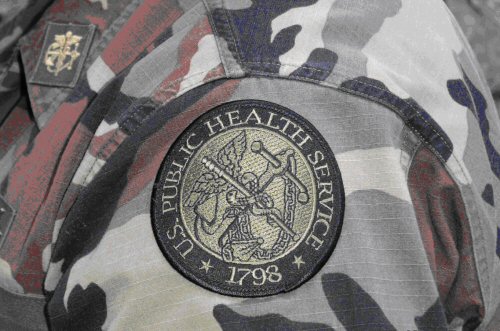
-
The USPHS name tape does not contain dots/periods between each letter.

-
Skill badges worn above the USPHS name tape are centered above the name tape with a ¼” space between the top of the name tape and the material of the skill badge. Shiny or subdued metal skill badges are not authorized.
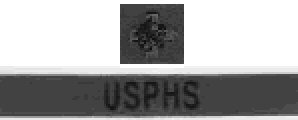
-
For routine deployments (in non-tactical environments), the only authorized undershirt is the black 100% preshrunk cotton t-shirt. The shirt will have a 3 or 4 inch diameter PHS seal (i.e., the ‘Public Health Service – 1789’ seal) printed on the upper, left breast of the shirt. On the back of the shirt vertically centered at about the mid-point of the shoulder blades, in 2-inch high Arial font, ‘U.S. Public Health Service’ will be printed on three lines with ‘U.S.’ on the first line, ‘Public Health’ on the second line, and ‘Service’ on the third line. The PHS Seal and the letters on the back of the undershirt shall be the same yellow as in the yellow quarantine flag when operating under non-tactical conditions. The t-shirts sold by the Navy Exchange and the PHS Officer’s Supply Center meet the specifications as described in the original design authorization, established in September 2005. Please note: Other commercial moisture wicking materials or weaves are not
authorized for wear with the BDUs.

-
Unless you are detailed on official personnel orders to a Department of Defense organizational unit, the wear of the reverse field, full color U.S. Flag patch on the right shoulder is not authorized and has not been authorized since 27 September 2006, per Personnel Operations Memorandum (POM) 06-003, “U.S. Flag, Special Skill and Unit Patches,” and Commissioned Corps Instruction (CCI) 26.3.7, “Special Uniform Situations,” dated 24 September 2008. The subdued or olive drab U.S. Flag patch is not authorized for wear.
-
Unless directed by the National Uniform Authority (NUA) or Local Uniform Authority (LUA), an officer may roll his/her sleeves in the BDU. The sleeve must be rolled above the elbow, but no more than 3 inches above the elbow. The inside of the material will face outward when properly rolled.
-
How to roll your sleeves:
Step 1: Lay the sleeve out and flatten it.
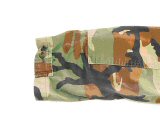
-
Step 2: Fold over the top of the sleeve approximately 2 fingers width. You can fold it more or less depending on the thickness of you biceps and how snug you want the sleeves to be.

-
Step 3: While gripping the fold you've just made, fold over the cuffs about 3 fingers wide. This is the start of the sleeve roll.
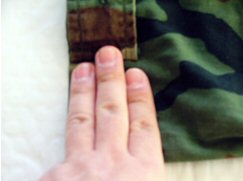
-
Step 4: While continuing to hold the initial fold, continue the roll that you've started.
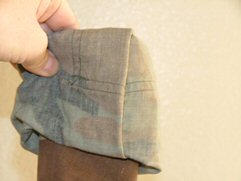
-
Repeat this several times until the roll is about 6 to 8 inches from the shoulder seam.

-
In the end, if done properly, the roll should be snug around your arms and not too puffy.
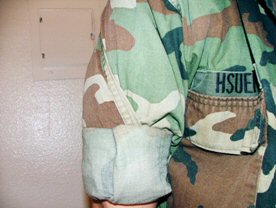
-
BDU trousers are required to be bloused. There are several commercially made items which you can use to accomplish this task, such as: the olive drab elastic bands with metal hook closure, Velcro ® elastic straps, or metal spring bands, all of which go over the top (calf area) of the combat boot. The bottom of the trousers should be tucked/roll under the blousing strap; this may take more than one tuck/roll. The knot of the bootlaces and the green tie straps of the BDUs should not be visible when properly bloused. Also, there should not be a gap from the bottom of the trouser to the top of the combat boot (e.g., socks, regardless of color or skin, should not show).

Questions and Answers
Q: Are officers authorized to travel in uniform?
A: Yes, with exception for travel overseas (this requires authorization from the Surgeon General). According to Commissioned Corps Instruction CC26.3.1 “Uniforms and Appearance,” dated 1 March 2008, Sections 6-11 and 6-12:
6-11. Travel Uniform.
- Travel by Non-Military Conveyances. For official travel within the United States, an officer may wear the uniform prescribed in Subsection 6-12, or appropriate civilian attire. For official travel outside the United States, appropriate civilian attire will normally be worn (see Subsection 6-13).
- Travel by Military Conveyance. When traveling in military-owned or military-controlled conveyances, active duty officers are authorized to wear civilian clothing; however, officers are also authorized and strongly encouraged to wear the Corps uniform, as prescribed in Subsection 6-12, except in the following circumstances:
- The officer shall not wear the uniform when military officials advise that entry requirements into a foreign area of destination prohibit wearing the uniform (contact the local Air Mobility Command terminal for status of the country, as given in the Air Force Foreign Clearance Guide);
- The officer shall not wear the uniform when military officials or the U.S. Department of State advise that the traveler will be passing through high-risk areas with respect to terrorist activities or social or political unrest;
- The officer shall wear the uniform when travelers belonging to the service that are providing the conveyance are required to travel in uniform; or
- Officers shall wear the uniform when the officer in charge of a group (two or more) of Corps officers traveling together specifies, in accordance with all rules and regulations, that the uniform will be worn.
6-12. Prescribed Uniforms.
- Official Travel. Service Dress Blue (SDB) or as specified in orders (see CC24.1.4, "Space-Required Travel on Military Aircraft").
- Unofficial Travel.
- SDB, or
- Corps uniform of the day for the area of destination.
Q: For the Extreme Cold Weather Clothing System (ECWCS) parka, I’m finding it hard to find the olive drab slide-on rank insignia for the rank tab.
Is the subdued metal rank authorized?
A: Yes, according to CCI 26.3.7 “Special Uniform Situations,” Section 6-4 (d)(1): Subdued, embroidered, slip-on cloth loop or miniature subdued metal rank insignia shall be worn on the tab on the front of the parka. If purchasing the subdued metal, be sure to order the Navy version, not the Army or Air Force version, as the differences are the same as the regular shiny versions of the rank insignia.

|













